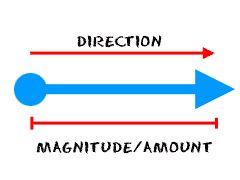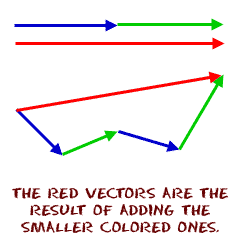Vector Basics
 Force is one of many things that are vectors. What the heck is a vector? Can you hold it? No. Can you watch it? No. Does it do anything? Well, not really. A vector is a numerical value in a specific direction, and is used in both math and physics. The force vector describes a specific amount of force and its direction. You need both value and direction to have a vector. Both. Very important. Scientists refer to the two values as direction and magnitude (size). The alternative to a vector is a scalar. Scalars have values, but no direction is needed. Temperature, mass, and energy are examples of scalars.
Force is one of many things that are vectors. What the heck is a vector? Can you hold it? No. Can you watch it? No. Does it do anything? Well, not really. A vector is a numerical value in a specific direction, and is used in both math and physics. The force vector describes a specific amount of force and its direction. You need both value and direction to have a vector. Both. Very important. Scientists refer to the two values as direction and magnitude (size). The alternative to a vector is a scalar. Scalars have values, but no direction is needed. Temperature, mass, and energy are examples of scalars.
When you see vectors drawn in physics, they are drawn as arrows. The direction of the arrow is the direction of the vector, and the length of the arrow depends on the magnitude (size) of the vector.
Real World Vectors
 Imagine a situation where you're in a boat or a plane, and you need to plot a course. There aren't streets or signs along the way. You will need to plan your navigation on a map. You know where you're starting and where you want to be. The problem is how to get there. Now it's time to use a couple of vectors. Draw the vector between the two points and start on your way. As you move along your course, you will probably swerve a bit off course because of wind or water currents. Just go back to the map, find your current location, and plot a new vector that will take you to your destination. Captains use vectors (they know the speed and direction) to plot their courses.
Imagine a situation where you're in a boat or a plane, and you need to plot a course. There aren't streets or signs along the way. You will need to plan your navigation on a map. You know where you're starting and where you want to be. The problem is how to get there. Now it's time to use a couple of vectors. Draw the vector between the two points and start on your way. As you move along your course, you will probably swerve a bit off course because of wind or water currents. Just go back to the map, find your current location, and plot a new vector that will take you to your destination. Captains use vectors (they know the speed and direction) to plot their courses.
Combining Vectors
We're hoping you know how to add and subtract. Scientists often use vectors to represent situations graphically. When they have many vectors working at once, they draw all the vectors on a piece of paper and put them end to end. When all of the vectors are on paper, they can take the starting and ending points to figure out the answer. The final line they draw (from the start point to the end point) is called the Resultant vector. If you don't like to draw lines, you could always use geometry and trigonometry to solve the problems. It's up to you. Unlike normal adding of numbers, adding vectors can give you different results, depending on the direction of the vectors.
Or search the sites for a specific topic.
- Overview
- Forces
- Vectors
- Laws of Motion
- Energy of Motion
- Velocity
- Momentum
- Friction
- Gravity
- Work
- More Topics

Real World: How Gears Work (NASA-eClips Video)

Useful Reference Materials
Encyclopedia.com (Vector):http://www.encyclopedia.com/topic/vector.aspx
Encyclopedia.com (Scalar):
http://www.encyclopedia.com/topic/scalar.aspx
Wikipedia (Vector):
http://en.wikipedia.org/wiki/Vector_(mathematics_and_physics)
Wikipedia (Scalar):
http://en.wikipedia.org/wiki/Scalar_(physics)
Encyclopædia Britannica (Vector):
http://www.britannica.com/EBchecked/topic/1240588/vector





